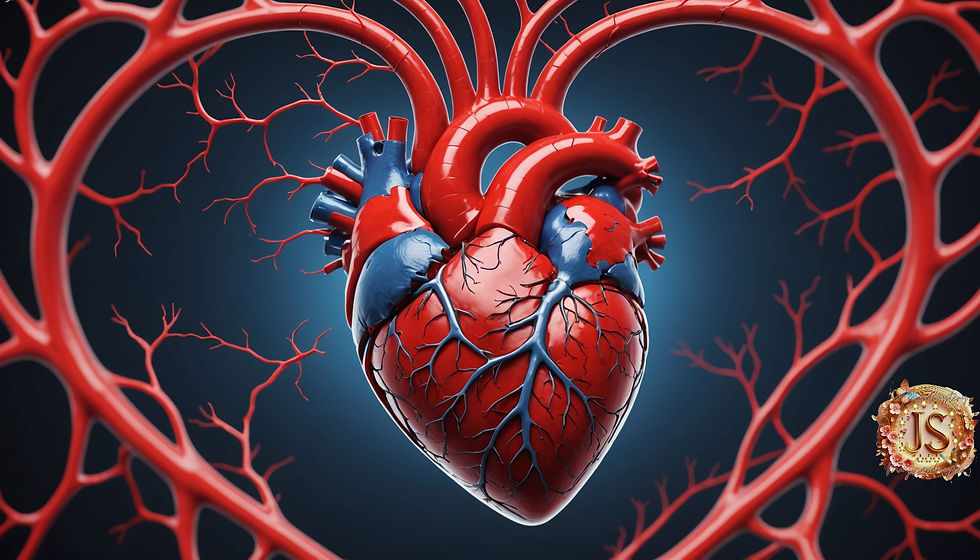Find Out All About The Marvellous Heart: How Does It Really Work? All Will Be Revealed
- Salma H
- Feb 3
- 5 min read
The heart is often called the "engine" of the body because it pumps blood and keeps us alive. Yet, despite this critical role, many people do not know how the heart works. Understanding this remarkable organ can help us appreciate its importance for our health. This post breaks down the heart's structure, rhythm, and functions in a way that is clear and engaging.
The Anatomy Of The Heart
To truly understand how the heart operates, we must first dive into its anatomy. The heart is roughly the size of a fist and sits slightly left of the center of the chest. It consists of four chambers:
The right atrium
The right ventricle
The left atrium
The left ventricle
Surrounding these chambers are three layers of tissue: the epicardium (outer layer), the myocardium (muscle layer), and the endocardium (inner layer). These layers work together seamlessly to enable the heart to contract and pump blood effectively.
The heart also contains valves that ensure blood flows in only one direction. The four main valves are:
The tricuspid valve (between the right atrium and right ventricle)
The pulmonary valve (between the right ventricle and pulmonary artery)
The mitral valve (between the left atrium and left ventricle)
The aortic valve (between the left ventricle and aorta)
Grasping the heart's anatomy lays the groundwork for understanding its complex functions.

The Heart's Electrical System
The heart's function hinges on its electrical system, which regulates heart rate and rhythm. At the heart of this system is the sinoatrial (SA) node, known as the heart's natural pacemaker. Situated in the right atrium, this cluster of cells generates electrical signals that kick off each heartbeat.
When the SA node sends out a signal, it prompts the atria to contract, pushing blood into the ventricles. The signal then travels to the atrioventricular (AV) node, where it briefly pauses before moving through the bundle of His and into the Purkinje fibers. This organized electrical activity allows the heart to beat synchronously, ensuring efficient blood pumping.
Malfunctions in this electrical system can result in arrhythmias, which disrupt normal heart rhythms. It's crucial to understand the heart's electrical workings to appreciate its significance to overall health.

How Blood Flows Through The Heart
The heart's primary role is pumping blood throughout the body, delivering oxygen and nutrients while eliminating waste. This blood flow can be segmented into two primary circuits: the pulmonary circuit and the systemic circuit.
Pulmonary Circuit:
The process starts when deoxygenated blood returns to the heart from the body through the superior and inferior vena cavae into the right atrium. When the right atrium contracts, blood flows through the tricuspid valve into the right ventricle. Upon contraction of the right ventricle, blood is pushed through the pulmonary valve into the pulmonary artery, destined for the lungs. In the lungs, carbon dioxide is exchanged for oxygen, renewing the blood.
Systemic Circuit:
Oxygen-rich blood returns via the pulmonary veins into the left atrium. When the left atrium contracts, blood moves through the mitral valve into the left ventricle. The left ventricle, being the strongest chamber, contracts powerfully to propel blood through the aortic valve into the aorta, distributing oxygenated blood throughout the body.
This continuous cycle occurs seamlessly, providing the steady blood flow essential for survival.

The Role Of The Heart In Homeostasis
The heart is vital for maintaining homeostasis, keeping the body stable as external conditions change. It adjusts its heart rate and blood pressure to respond to the body's needs.
For example, during exercise, your body's demand for oxygen increases. In response, your heart speeds up, pumping more blood to support this need. Conversely, when resting, the heart rate slows down, allowing the body to conserve energy.
Hormonal signals also play a role in heart function. For instance, during stress, the adrenal glands release adrenaline, increasing heart rate and strength to prepare for action. This response can be lifesaving, as it allows the body to quickly react to emergencies.
Understanding the heart’s involvement in homeostasis reveals its significance in maintaining our overall health.
The Impact Of Lifestyle On Heart Health
The heart is a resilient organ, but our lifestyle choices significantly affect its health. Key factors include:
Diet: High intakes of saturated fats, sugars, and salt can contribute to obesity, high cholesterol, and high blood pressure, significantly increasing the risk of heart disease. In contrast, diets rich in whole grains, fruits, vegetables, and lean proteins have been shown to lower heart disease risk by 30-40%.
Exercise: Regular physical activity strengthens the heart muscle, improves blood circulation, and helps maintain a healthy weight. Engaging in 150 minutes of moderate aerobic activity weekly can reduce the risk of heart disease by up to 50%.
Smoking: Tobacco use is a leading cause of heart disease. Smokers are two to four times more likely to develop heart disease than non-smokers.
Stress Management: Chronic stress can lead to unhealthy habits such as overeating or smoking, negatively impacting heart health. Techniques like mindfulness and relaxation can help reduce stress and enhance heart health.
Making informed lifestyle choices is crucial for maintaining heart health and preventing disease.
Recognising Heart Disease
While the heart is sturdy, it can be vulnerable to various diseases, each with distinct symptoms and risk factors. Common types include:
Coronary Artery Disease (CAD): This condition arises when the coronary arteries narrow or become blocked, limiting blood flow to the heart.
Heart Attack: A serious event occurs when blood flow to a portion of the heart is obstructed, damaging heart tissue.
Heart Failure: This chronic condition prevents the heart from pumping blood effectively, leading to symptoms like fatigue and shortness of breath.
It's essential to recognize the signs of heart disease, which may include chest pain, fatigue, shortness of breath, and swelling in the legs or abdomen. Early detection and swift action can make a significant difference in managing these conditions.
Importance Of Regular Check-Ups
Routine check-ups with a healthcare provider are crucial for monitoring heart health. During these evaluations, healthcare professionals typically measure:
Blood pressure
Cholesterol and blood sugar levels
Body mass index (BMI)
Regular screenings can detect potential heart issues before they escalate, allowing for early intervention. Discussing family history and any noticeable symptoms with a healthcare provider also helps in developing personalized strategies for heart health.
Understanding how the heart functions adds to our appreciation of its crucial role in our overall well-being. From its intricate design to the complex processes involved in blood flow and electrical impulses, the heart is an extraordinary organ at the center of our health.
Maintaining heart health through wise lifestyle choices, regular check-ups, and awareness of disease signs is vital for enhancing both longevity and quality of life. Continued research on the heart's mysteries further highlights the importance of nurturing this essential engine within us, ensuring we provide it with the care it needs.
Sponsor


Comments